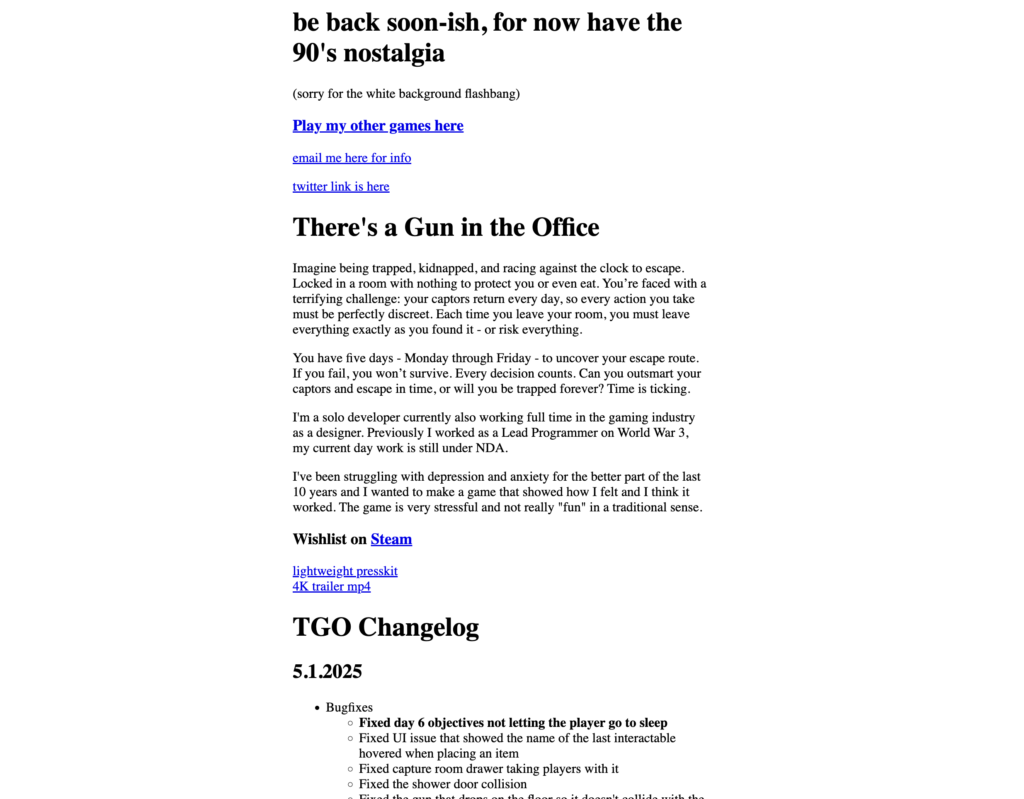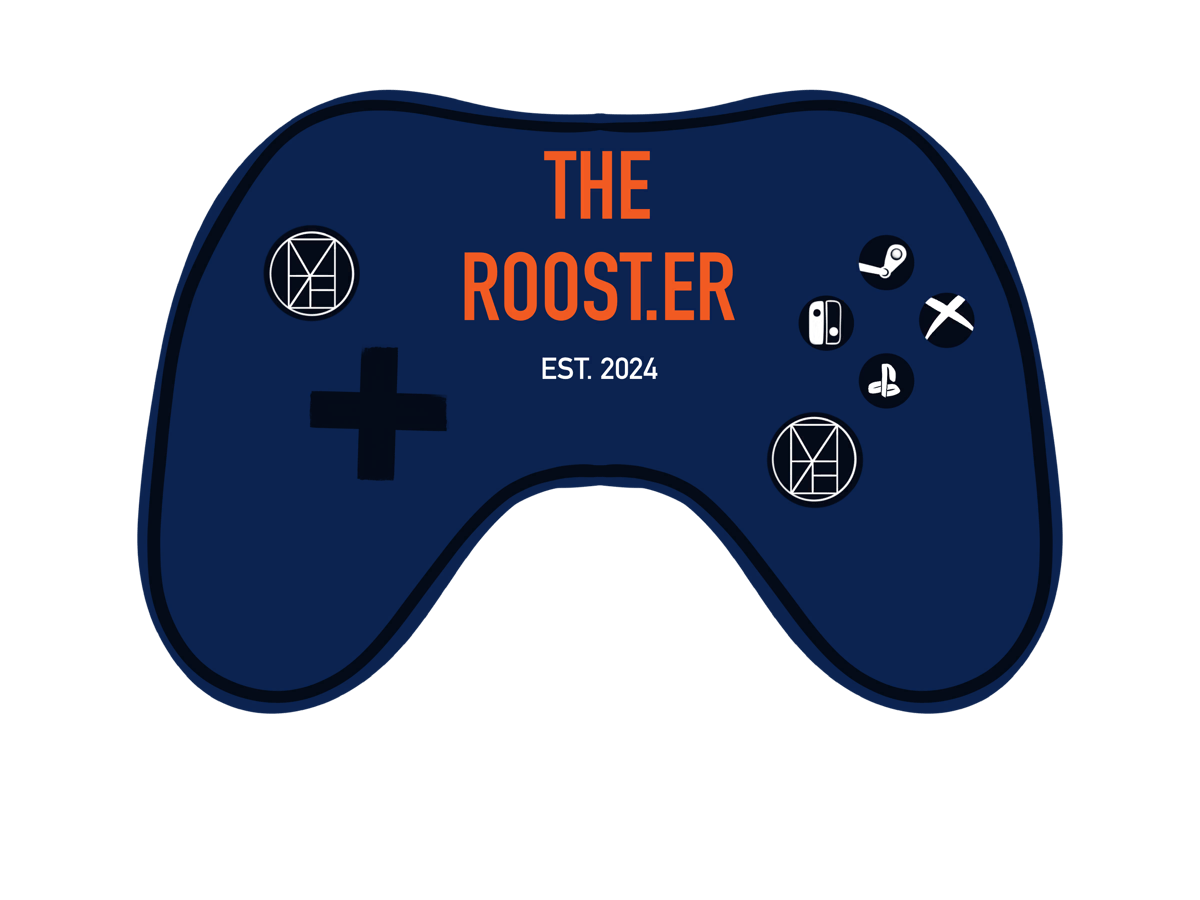To preface: I have never personally been a fan of horror games. Horror movies? Love them, curl up on the couch with some delicious popcorn, couldn’t get better. Haunted houses? Absolutely, let’s go get the crap scared out of us and scream like tiny children. But horror games? Not my thing. When I play a game, I play to relax. Whether that relaxed state of mind be through killing zombies, farming endermen, or desperately building up a wall so I don’t get killed, the key is relaxation. Horror games are quite the opposite. Your blood starts pumping, heart starts racing, and that tiny little voice inside your head that harshly judges every thriller protagonist – well, it gets strangely quiet.
That being said… When I saw this game, I figured I would give it a try. The premise was very escape-room styled, and the author’s website was a flashback of nostalgia to the late 90’s.

I picked up this game as part of a Fanatical bundle (100% my favorite site when it comes to third party deals) alongside a few other games, but this is one of the ones that I activated immediately. The premise of the game is as such: you (the kidnappee) has been locked into the house while the kidnapper goes off to work. You’ve managed to smuggle away the key to your room, and have a week total to explore the house, plan out your escape, and execute it. Unlike other horror / escape combos, each day you must reset your own progress. That’s correct, you must reset the progress of the game yourself. If the kidnappers come home and find anything out of place, it’s game over for you. So every day, you have until 4:55 PM to get out, explore/manipulate/plan, reset, and finish the day by locking yourself back in and going to sleep.

As the game loads in, the main menu provides the image of a normal apartment: a few closed doors, an ugly vase, a statue of a cat, etc etc. All things that one would expect to see. The game itself has a slight sway to the camera, an immersive feature that can be disabled in the settings if you so desire. (Did I know this could be changed until 3/4 of the way through the game? No, no I did not. Did this cause me much frustration? Yes. Yes it did.) The menu itself is very simplistic and fits with the minimalism theme from the apartment – continue, new game, settings, and language.
When you click New Game, you start day one: Monday. Before the screen is released to player control, you must deal with the cutscenes. Unlike some games, these cutscenes really provide no narrative benefit, choosing instead to focus on the player’s immersion. It’s almost like watching a clip of a news scene, with a few random scenes being played while the text overlay provides a rough idea of the needs for the day.

As the game loads in, you start in the bedroom. Having been alerted that there is a key to your room hidden somewhere, you might start by looking around. However, even if you find the key, you can’t grab it yet. You must complete certain tasks, like grabbing your notepad from the desk, before you can proceed. The two things you grab from the desk – the watch and the notepad – serve critical purposes in game (the watch being your main source of partitioning out your time and the notepad giving you the most detailed objectives). Once you’ve gotten both the notepad and the watch, however, you are free to grab the key and unlock your door.
What makes this particular game so challenging is the splitting of precise actions. In most games, the action of unlocking the door is one move – get the key into the door and turn. In this game, this isn’t the case. The simple mechanic of splitting the placing of the key and the turning of the key increases the difficulty of this game dramatically, especially with how fast the time runs out. While I suspect this would be much easier on a keyboard, using a controller caused several bouts of rage and frustration, because the act of unlocking the door took almost triple the amount of time it should have – between trying to land the cursor perfectly on the lock, keeping it there with the sway long enough to click through the button prompts twice, and then letting said cursor drift just enough to highlight the door instead and click through the opening button prompt.
Similarly, by the nature of the game, you are trying to be as precise as possible. So when you put a key back, take a food item, move things around, or anything else, you need to remember exactly where it came from. This, along with actually placing it down, is another large chunk of in-game time – trying to make sure each key is oriented perfectly as it was found.

Once you’ve finally managed to unlock the bedroom door (and perhaps taken a moment to either celebrate or question why you signed up for this level of stress), the real game begins. The apartment reveals itself in layers. Each day offers new opportunities to explore different rooms, discover hidden items, and piece together a plan. But – and this is the brilliance and frustration of the game – you’re racing against the clock. The time mechanics are as much your enemy as the kidnappers themselves. The clock seems to sprint forward the moment you get immersed in a task, leaving you scrambling to reset everything perfectly before 4:55 PM. Forget to put that key back at the exact angle it was originally lying? Game over. Move the bowl slightly to the left and fail to reposition it just right? Game over. The margin for error is razor-thin, making every action feel both consequential and maddening.

That being said, the game shines in its immersive design and attention to detail. Every object feels purposeful, every room thoughtfully crafted. The apartment has this eerie, lived-in quality: both mundane and deeply unsettling. The slight imperfections in the decor, the scattered personal belongings, and even the sound design (oh, the creaking floors!) contribute to an atmosphere that’s as oppressive as it is captivating. Speaking of sound, it deserves a special mention. There’s no dramatic score here – just the ambient sounds of the apartment. Footsteps, doors creaking, the hum of appliances… all of it conspires to make you feel constantly watched, even when you know (or at least hope) the kidnappers aren’t home. If you’re someone who gets easily spooked by silence interrupted by sudden noises, well, you’re in for a treat. Or maybe a nightmare.
As you progress through the week, the puzzles become more complex, and the stakes feel higher with each passing day. The game cleverly balances the sense of discovery with the constant threat of failure. For example, finding a key to a previously locked door might feel like a victory – until you realize you now have less than two in-game hours to explore, catalog, and put everything back in place before the kidnappers return. It’s a constant dance of risk and reward, and the game doesn’t hold your hand. If anything, it seems to revel in tripping you up.

And yet, despite the frustration (or maybe because of it), there’s something incredibly satisfying about piecing together the puzzle. Every small victory, whether it’s unlocking a new room, deciphering a cryptic note, or simply surviving another day, feels hard-earned. The game forces you to think several steps ahead, to plan meticulously, and to pay attention to details you might otherwise overlook. By the end of the week (assuming you make it that far), the sense of accomplishment is immense. Escaping the apartment feels less like completing a game and more like surviving an ordeal. It’s not a relaxing experience by any stretch, but it’s undeniably memorable.
This game is not for everyone. If you’re looking for a casual, stress-free experience, steer clear. But if you enjoy a challenge, relish the thrill of high-stakes gameplay, and don’t mind a bit of frustration along the way, this might just be the game for you. It’s equal parts escape room, stealth mission, and psychological endurance test.
Has this changed me into a die-hard horror fan? Probably not. But would I recommend it to someone braver (or more masochistic) than me? Absolutely. Just don’t forget to breathe…. and maybe keep some stress-relief tools nearby. You’re going to need them.
